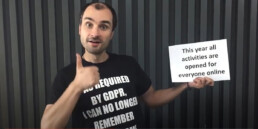How We Brought Our Annual Cyber Security Event To The Digital Space
As a tech business, we set cybersecurity high on our agenda. Not just our own security: making sure our customers are safe is what drives us.
That’s why we want everyone in Levi9, not just to be aware of the topic, but also to feel ownership. To achieve that on top of awareness programme, we run an annual cybersecurity event – Secure9. The event lasts a whole week and is a mix of sessions, competitions, and challenges – we make sure there’s something for everyone!
Normally we would do this in each of our offices – across all Levi9 locations, but, well, y’know… COVID had other ideas. But we didn’t let that stop us from pursuing our plans. Instead we asked ourselves: Could we bring the event to the digital space? Would it work even better online?
When it came to doing things like inviting customers to participate in the activities, getting the best speakers from all over the world, and hosting the event in one place, the answer to both questions was… Yes! After all it is not a space that connects us – it’s having the right mentality. But could we inspire everyone?
Active Engagement
At Secure9 everyone has the opportunity to participate in the sessions they’re most interested in. And as we want as many levi niners as possible to get involved, we went the extra mile in preparing some truly insightful content and arranging engaging activities.
For example, we held ‘Special Agent 009’ challenges throughout the week, and a ‘Capture the flag’ competition – a simulation where teams needed to exploit vulnerabilities in a system in order to understand a hacker’s mentality. This experience helped everyone better understand what we can all do to make the life of an attacker more difficult and to protect ourselves and our customers from potential threats. And a hands-on approach is a lot more memorable than an hour-long seminar
Together With Customers
Given the online format of this year’s events we were able to invite all of our customers – not only as keynote speakers but also as participants in our activities. While we’re in constant dialogues with customers around cybersecurity, having teams where customers work together with levi niners gave them a totally different experience and a truly deep insight into our approach to security at Levi9.
Admittedly, inviting customers meant some logistical challenges (like ordering pizzas and Happy Hour packages for the participants - everywhere from Iceland to Ukraine). But it was definitely worth the effort and we were happy to see the dialogue about security continue naturally also after the event.
Same Time, Same Place, Next Year?
Holding Secure9 totally online was a fantastic experience, and it was great to see everyone engaging in the same way, at the same time, in the digital space.
And on top of that we learned that:
- holding an online event can lead to even better outcomes and attendance than on-site event (according to the evaluation, most people would prefer an online format for next year’s event)
- including our customers in events like this help strengthening your partnership
- cybersecurity can be a topic that brings us together, if addressed in the right way.
So see you at Secure9 2021? Same time, same place, next year?
Futureproofing an E-commerce champion
Online retail is a massive growth industry, boosted by the global pandemic into a wildfire of digital transformation.
With physical stores facing enforced closure or restricted access, consumers have been converting to shopping online like never before at breakneck speed – sending shipping costs off the charts, along with profits, price competition, traffic declines, inventory overages, and overstocking.
Based on annual Twinkle100 ecommerce data, in 2019 Wehkamp was ranked 5th biggest Dutch e-commerce with a total of 530 millions Euros online turnover with more than 11 million orders processed annually. Wehkamp is one of the oldest online retailers in the Netherlands, starting as a mail-order company in 1952. Today is one of the Netherlands’ online market leaders in fashion, lifestyle, beauty and baby/childrenswear.
Fundamental Shift In Wehkamp’s IT Infrastructure
Just ahead of the pandemic, Wehkamp had undertaken a year-long digital transformation – to enable agile development of its core processes across the business: from warehousing, stock control and dispatch; to procurement, invoicing, and supply chain management.
The journey had not been a simple system replacement. At every step, an evidence-based methodology was needed to demonstrate the need for such a radical approach – and how it would benefit the organisation.
With all of this in mind, Wehkamp partnered with Levi9 to bring about what became a fundamental and radical shift in the organisation. The task very quickly morphed from what at first seemed straightforward – a systems upgrade to futureproof and make processes robust enough to cope with increasingly sophisticated demands.
Top Down Buy-In To Change Hearts & Minds
From the outset, a team was established and tasked with changing the way people were looking at things, from the very top (Wehkamp’s CTO) down. The fact that the project gained the full backing of the board was strategically important for future development and profitability.
In practice, digital transformation required substantial planning and investigation in the discovery phase – through painstaking attention to detail to deliver bite-sized training and implementation handover to Wehkamp’s operational teams.
The legacy system was built on Microsoft’s BizTalk platform. Whilst adequate for the business up until then, it is an expensive solution and tied into processes that needed also upgrading and maintenance.
The alternative – that both Levi9 and Wehkamp team established as the most effective option – was an open-source system, NiFi. This is a software project from the Apache Software Foundation designed to automate the flow of data between software systems – one that’s based on the “NiagaraFiles” software previously developed by the US National Security Agency.
The rationale for the move was demonstrated through the discovery phase, after an extensive search and trial of options in the market, and Proof of Concept workshops that established the operational and business case.
Making The Case For Exploration
Initially, the project wasn’t getting the same high level of support from all teams – mainly because the new way was so different, both in terms of the architecture and processes used.
These factors made the project appear high risk with little chance of success. But thanks to some intense explanatory workshops and demos, the implementation team of both Levi9 and Wehkamp made the case.
From the outset it was understood that in order to hand over such a sophisticated and very different system at the end of the project would not just be unfeasible, but would also create an unfair burden on the operational teams.
That’s why the implementation team adopted weekly integrated scrum and iterative training sessions to bring the operational team up to speed – which helped to create and sustain enthusiasm across the year-long project.
Overnight, through implementation across NiFi, Wehkamp’s systems and digital teams were free to use a range of platforms. This had the added benefit of slashing costs – with no need for licences – and the ability to develop incremental implementation as and when the business needed to deploy or upgrade various processes.
Distributing Data Processing
Probably the biggest challenge was organisational. The move to a distributed environment meant that data could be accessed at various geographical locations and available locally most of the time.
A positive outcome is that data and software processing will become distributed – actively reducing the impact of any particular site or hardware failure.
Most importantly, this strategy empowered smaller teams – providing ownership and installing agile processes – as opposed to the existing centralised team, which although had the expertise, could potentially be a bottleneck.
The spin-off benefit for the smaller operational teams – and also advantageous to the organisation will be the ability to migrate flows; as well as faster problem solving, decision-making, and implementation. This required a substantial leap of faith from the senior team, who had previously considered a radical change to be too risky for an organisation totally dependent upon efficient processes and flows.
Ultimately, the joint Levi9/Wehkamp team proved the benefits of Workflows-As-A-Service – as a cost model for Wehkamp. Maintenance is minimal and there’s no dependency on a single point of failure.
With online retailing only ever increasing, Wehkamp is now set up to provide superior customer experiences, efficient organisation, and can now take on competitors in one of the world’s most dynamic markets: online shopping.
22 Oct - Webinar DevOps engineer
October 22nd 2020
Why become a DevOps engineer?
The term DevOps has become increasingly popular in recent years.
Have you ever wondered what the term represents, who DevOps engineers are, and why nowadays, so many companies are looking for DevOps engineers?
At this webinar, we offered guests the opportunity to find out what a DevOps does at Levi9, what kind of knowledge you need to become a DevOps, and what awaits you in our DevOps internship. We will also be in a great mood to answer all your questions!
Want to find out more about our DevOps positions? Contact us at the button to the right.
26 Nov - Webinar Product Discovery
November 26th 2020
We will focus on one of the techniques – User Story Mapping
Webinar Product Discovery with Raimo van der Klein
Understanding the business goals of our customers and the needs of their users is an essential part of building the right, high-quality, software solutions.
But how do you ensure that the development teams understand the bigger picture (why do we need it) and know what to build to fulfill those needs?
How do you accomplish a common understanding between business and IT?
In what way do you engage the development teams to think together with business representatives?
How would you approach all these challenges while working remotely?
There are many techniques that can help in accomplishing this, realizing your business goals.
During this webinar, our experts Nina Stanic and Dragana Stanković will focus on one of those techniques – User Story Mapping in practice.
You will be taken through the whole process, from the preparation phase and follow-up actions to the implementation stage.
We are excited to have Raimo van der Klein – Chief Product & Technology Officer at Incision as our guest speaker, who is an expert in this field and has experienced USM workshops during the partnership with Levi9.
“Raimo has been board member, founder and CEO of Layar, a global leader in Augmented Reality and Interactive Print, helping to bridge the gap between print and digital worlds.
Raimo has been active in the startup domain since 2008 and has served as a mentor at Rockstart, an advisor to Startup Amsterdam and advisor to several startups. He has written many articles related to team dynamics in combination with autonomous teams like founder teams.”





